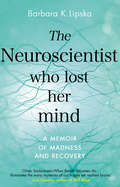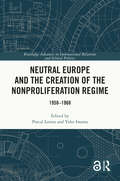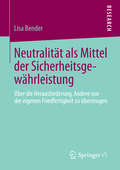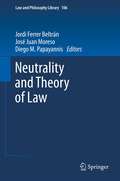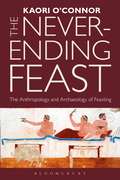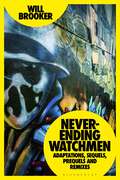- Table View
- List View
Neuroscience and Media: New Understandings and Representations (Routledge Research in Cultural and Media Studies)
by Michael GrabowskiThis volume explores how advances in the fields of evolutionary neuroscience and cognitive psychology are informing media studies with a better understanding of how humans perceive, think and experience emotion within mediated environments. The book highlights interdisciplinary and transdisciplinary approaches to the production and reception of cinema, television, the Internet and other forms of mediated communication that take into account new understandings of how the embodied brain senses and interacts with its symbolic environment. Moreover, as popular media shape perceptions of the promises and limits of brain science, contributors also examine the representation of neuroscience and cognitive psychology within mediated culture.
Neuroscience and Media: New Understandings and Representations (Routledge Research in Cultural and Media Studies)
by Michael GrabowskiThis volume explores how advances in the fields of evolutionary neuroscience and cognitive psychology are informing media studies with a better understanding of how humans perceive, think and experience emotion within mediated environments. The book highlights interdisciplinary and transdisciplinary approaches to the production and reception of cinema, television, the Internet and other forms of mediated communication that take into account new understandings of how the embodied brain senses and interacts with its symbolic environment. Moreover, as popular media shape perceptions of the promises and limits of brain science, contributors also examine the representation of neuroscience and cognitive psychology within mediated culture.
Neuroscience for Psychologists: An Introduction
by Marc L. ZeiseThis textbook is intended to give an introduction to neuroscience for students and researchers with no biomedical background. Primarily written for psychologists, this volume is a digest giving a rapid but solid overview for people who want to inform themselves about the core fields and core concepts in neuroscience but don’t need so many anatomical or biochemical details given in “classical” textbooks for future doctors or biologists. It does not require any previous knowledge in basic science, such as physics or chemistry. On the other hand, it contains chapters that do go beyond the issues dealt with in most neuroscience textbooks: One chapter about mathematical modelling in neuroscience and another about “tools of neuroscience” explaining important methods. The book is divided in two parts. The first part presents core concepts in neuroscience:Electrical Signals in the Nervous SystemBasics of NeuropharmacologyNeurotransmitters The second part presents an overview of the neuroscience fields of special interest for psychology:Clinical NeuropharmacologyInputs, Outputs and Multisensory ProcessingNeural Plasticity in HumansMathematical Modeling in Neuroscience Subjective Experience and its Neural Basis The last chapter, “Tools of Neuroscience” presents important methodogical approaches in neuroscience with a special focus on brain imaging. Neuroscience for Psychologists aims to fill a gap in the teaching literature by providing an introductory text for psychology students that can also be used in other social sciences courses, as well as a complement in courses of neurophysiology, neuropharmacology or similar in careers outside as well as inside biological or medical fields. Students of data sciences, chemistry and physics as well as engineering interested in neuroscience will also profit from the text.
The Neuroscience of Manifesting
by Dr Sabina BrennanDiscover the magical science of getting the life you want In The Neuroscience of Manifesting, psychologist and neuroscientist Dr Sabina Brennan uses cutting edge research to demonstrate that the power to manifest the life of our dreams resides within us all. By grounding key manifestation principles in science, Dr Brennan shows that manifesting does not require blind trust or faith in higher powers. Instead, it requires changing how you think and behave, and learning how to harness the power of your brain. Through breaking down complicated neuroscience into empowering everyday strategies, this book will show you how to:- Gain clarity on what you really want - Cultivate more self-compassion- Connect with your true self- Take considered action to bring about the change you desire-Create your best life using effective, scientifically grounded techniques
The Neuroscientist Who Lost Her Mind: A Memoir of Madness and Recovery
by Dr Barbara K. Lipska'Oliver Sacks-meets-When Breath Becomes Air ... Barbara Lipska's remarkable story illuminates the many mysteries of our fragile yet resilient brains.' LISA GENOVA, bestselling author of Still Alice and Every Note PlayedAll we think, feel and dream, how we move, if we move, everything that makes us who we are, comes from the brain. We are the brain. So what happens when the brain fails? What happens when we lose our mind?In January 2015 renowned neuroscientist Barbara Lipska's melanoma spread to her brain. It was, in effect, a death sentence. She had surgery, radiation treatments and entered an immunotherapy clinical trial. And then her brain started to play tricks on her. The expert on mental illness - who had spent a career trying to work out how the brain operates and what happens when it fails - experienced what it is like to go mad.She began to exhibit paranoia and schizophrenia-like symptoms. She became disinhibited, completely unaware of her inappropriate behaviour. She got lost driving home from work, a journey she did every day. She couldn't remember things that had just happened to her. Small details like what she was having for breakfast became an obsession, but she ignored the fact that she was about to die. And she remembers every moment with absolute clarity.Weaving the science of the mind and the biology of the brain into her deeply personal story, this is the dramatic account of Dr Lipska's own brilliant brain gone awry.
NeuroTribes: The Legacy of Autism and How to Think Smarter About People Who Think Differently
by Steve SilbermanWinner of the Samuel Johnson Prize for Non-FictionShortlisted for the Wellcome Book PrizeShortlisted for the MJA Health Book of the Year AwardShortlisted for the BMA Medical Book AwardsA Sunday Times and New York Times bestsellerForeword by Oliver SacksWhat is autism: a devastating developmental condition, a lifelong disability, or a naturally occurring form of cognitive difference akin to certain forms of genius? In truth, it is all of these things and more - and the future of our society depends on our understanding it. Following on from his groundbreaking article 'The Geek Syndrome', Wired reporter Steve Silberman unearths the secret history of autism, long suppressed by the same clinicians who became famous for discovering it, and finds surprising answers to the crucial question of why the number of diagnoses has soared in recent years.Going back to the earliest autism research and chronicling the brave and lonely journey of autistic people and their families through the decades, Silberman provides long-sought solutions to the autism puzzle while casting light on the growing movement of 'neurodiversity' and mapping out a path towards a more humane world for people with learning differences.
Neutral Europe and the Creation of the Nonproliferation Regime: 1958-1968 (ISSN)
by Pascal Lottaz Yoko IwamaLottaz, Iwama, and their contributors investigate the role of neutral and nonaligned European states during the negotiations for the Treaty on the Nonproliferation of Nuclear Weapons (NPT).Focusing on the years from the Irish Resolution of 1958 until the treaty’s opening for signatures ten years later, the nine chapters written by area experts highlight the processes and reasons for the political and diplomatic actions the neutrals took, and how those impacted the multilateral treaty negotiations. The book reveals new aspects of the dynamics that lead to this most consequential multilateral breakthrough of the Cold War. In part one, three chapters analyze the international system from a bird’s eye perspective, discussing neutrality, nonalignment, and the nuclear order. The second part features six detailed case studies on the politics and diplomacy of Ireland, Sweden, Finland, Switzerland, Austria, and Yugoslavia. Overall, this study suggests that despite the volatile and dangerous nature of the early Cold War, the balance of the strategic environment enabled actors that were not part of one or the other alliance system to play a role in the interlocking global politics that finally created the nuclear regime that defines international relations until today.A valuable resource for scholars of nonproliferation, the Cold War, neutrality, nonalignment, and area studies.
Neutral Europe and the Creation of the Nonproliferation Regime: 1958-1968 (ISSN)
Lottaz, Iwama, and their contributors investigate the role of neutral and nonaligned European states during the negotiations for the Treaty on the Nonproliferation of Nuclear Weapons (NPT).Focusing on the years from the Irish Resolution of 1958 until the treaty’s opening for signatures ten years later, the nine chapters written by area experts highlight the processes and reasons for the political and diplomatic actions the neutrals took, and how those impacted the multilateral treaty negotiations. The book reveals new aspects of the dynamics that lead to this most consequential multilateral breakthrough of the Cold War. In part one, three chapters analyze the international system from a bird’s eye perspective, discussing neutrality, nonalignment, and the nuclear order. The second part features six detailed case studies on the politics and diplomacy of Ireland, Sweden, Finland, Switzerland, Austria, and Yugoslavia. Overall, this study suggests that despite the volatile and dangerous nature of the early Cold War, the balance of the strategic environment enabled actors that were not part of one or the other alliance system to play a role in the interlocking global politics that finally created the nuclear regime that defines international relations until today.A valuable resource for scholars of nonproliferation, the Cold War, neutrality, nonalignment, and area studies.
Neutralität als Mittel der Sicherheitsgewährleistung: Über die Herausforderung, Andere von der eigenen Friedfertigkeit zu überzeugen
by Lisa BenderDie Auflösung der Blöcke im Jahre 1990 hat eine grundlegende Veränderung der internationalen Sicherheitssituation hervorgerufen: Es entstanden neue Arten von Bedrohungen und neue Wege, diesen zu begegnen. In der Beobachtung, dass Neutralität als Phänomen der Sicherheitspolitik diesen Wegen fundamental entgegenzustehen scheint, findet Lisa Bender ihren Ausgangspunkt. Dem in der Literatur vorherrschenden statischen Begriffsverständnis setzt sie entgegen, dass Neutralität sich stets veränderten historischen Bedingungen wie der Organisation des Staates und der Form der Konfliktaustragung angepasst hat. Vor diesem Hintergrund entwickelt sie eine gegenstandsverankerte Vorgehensweise, um nach neuen und veränderten Bedeutungen von Neutralität zu fragen, und so der Frage nachzugehen, was Neutralität heute ist. Mithilfe der grounded theory generiert sie so aus der Perspektive der Akteure eine Theorie von Neutralität als Mittel der Sicherheitspolitik, das darauf beruht, Andere von der eigenen Friedfertigkeit zu überzeugen.
Neutrality and Theory of Law (Law and Philosophy Library)
by Jordi Ferrer Beltrán, José Juan Moreso and Diego M. PapayannisThis book brings together twelve of the most important legal philosophers in the Anglo-American and Civil Law traditions. The book is a collection of the papers these philosophers presented at the Conference on Neutrality and Theory of Law, held at the University of Girona, in May 2010. The central question that the conference and this collection seek to answer is: Can a theory of law be neutral? The book covers most of the main jurisprudential debates. It presents an overall discussion of the connection between law and morals, and the possibility of determining the content of law without appealing to any normative argument. It examines the type of project currently being held by jurisprudential scholarship. It studies the different approaches to theorizing about the nature or concept of law, the role of conceptual analysis and the essential features of law. Moreover, it sheds some light on what can be learned from studying the non-essential features of law. Finally, it analyzes the nature of legal statements and their truth values. This book takes the reader a step further to understanding law.
Neutrality in International Law: From the Sixteenth Century to 1945 (Routledge Advances in International Relations and Global Politics)
by Kentaro WaniNeutrality is a legal relationship between a belligerent State and a State not participating in a war, namely a neutral State. The law of neutrality is a body of rules and principles that regulates the legal relations of neutrality. The law of neutrality obliges neutral States to treat all belligerent States impartially and to abstain from providing military and other assistance to belligerents. The law of neutrality is a branch of international law that developed in the nineteenth century, when international law allowed unlimited freedom of sovereign States to resort to war. Thus, there has been much debate as to whether such a branch of law remains valid in modern international law, which generally prohibits war and the use of force by States. While there has been much debate regarding the current status of neutrality in modern international law, there is a general agreement among scholars as to the basic features of the traditional law of neutrality. Wani challenges the conventional understanding of the traditional neutrality by re-examining the historical development of the law of neutrality from the sixteenth century to 1945. The modification of the conventional understanding will provide a fundamentally new framework for discussing the current status of neutrality in modern international law.
Neutrality in International Law: From the Sixteenth Century to 1945 (Routledge Advances in International Relations and Global Politics)
by Kentaro WaniNeutrality is a legal relationship between a belligerent State and a State not participating in a war, namely a neutral State. The law of neutrality is a body of rules and principles that regulates the legal relations of neutrality. The law of neutrality obliges neutral States to treat all belligerent States impartially and to abstain from providing military and other assistance to belligerents. The law of neutrality is a branch of international law that developed in the nineteenth century, when international law allowed unlimited freedom of sovereign States to resort to war. Thus, there has been much debate as to whether such a branch of law remains valid in modern international law, which generally prohibits war and the use of force by States. While there has been much debate regarding the current status of neutrality in modern international law, there is a general agreement among scholars as to the basic features of the traditional law of neutrality. Wani challenges the conventional understanding of the traditional neutrality by re-examining the historical development of the law of neutrality from the sixteenth century to 1945. The modification of the conventional understanding will provide a fundamentally new framework for discussing the current status of neutrality in modern international law.
Neutrality in Southeast Asia: Concepts and Contexts (Routledge Studies in the Modern History of Asia)
by Nicholas TarlingThis book analyses the notion of neutrality to the politics of the state in Southeast Asia. Distinguishing among neutrality, neutralism and neutralisation, it asks what relation do the concepts bear to the independence of states, and how do they relate to other forms of inter-state relations and to participation in international organizations. The author considers concepts of neutrality and the policy of non-alignment as they were developed in South and Southeast Asia. Using case studies of a variety of Asian countries, including India, Burma, Cambodia and other countries in Southeast Asia, he discusses the novel notion of a regional form of neutralisation as a means of decolonising the region and examines the relevance neutralism has in current international politics and what might it have in the future. This new work by one of the most foremost historians on Southeast Asia is of interest to scholars in the field of Asian History, Politics, International Relations and Strategic Studies.
Neutrality in Southeast Asia: Concepts and Contexts (Routledge Studies in the Modern History of Asia)
by Nicholas TarlingThis book analyses the notion of neutrality to the politics of the state in Southeast Asia. Distinguishing among neutrality, neutralism and neutralisation, it asks what relation do the concepts bear to the independence of states, and how do they relate to other forms of inter-state relations and to participation in international organizations. The author considers concepts of neutrality and the policy of non-alignment as they were developed in South and Southeast Asia. Using case studies of a variety of Asian countries, including India, Burma, Cambodia and other countries in Southeast Asia, he discusses the novel notion of a regional form of neutralisation as a means of decolonising the region and examines the relevance neutralism has in current international politics and what might it have in the future. This new work by one of the most foremost historians on Southeast Asia is of interest to scholars in the field of Asian History, Politics, International Relations and Strategic Studies.
Neutron Methods for Archaeology and Cultural Heritage (Neutron Scattering Applications and Techniques)
by Nikolay Kardjilov Giulia FestaThis book provides an extensive overview of the application of neutron characterization techniques in cultural heritage to a broad audience and will be of interest to both scientists and non-scientists in the field. Archaeologists, paleontologists, restaurateurs and conservators, historians and collectors will be fascinated by the wealth of information that can be obtained using neutron techniques, while material scientists and engineers will find details of the experimental techniques and materials properties that can be determined. Neutrons, due to their weak interactions with materials, provide a penetrating, but non-invasive probe of bulk properties. They allow the characterization of the composition and mechanical properties of materials, helping to answer questions related to the dating, the manufacturing process or the state of degradation of artefacts. They allow detailed interrogation of the internal structures of objects that may be otherwise hidden from view. The first section of the book is dedicated to stories describing spectacular discoveries brought about by the use of neutron techniques in a range of applications. The second section covers the experimental techniques in appropriate detail: basic principles, limitations and fields of application.
Neuzuwanderung, sprachliche Bildung und Inklusion: Eine ethnographische Studie im Sekundarschulbereich (Inklusion und Bildung in Migrationsgesellschaften)
by Simone PlögerDie Studie untersucht, wie neu zugewanderte Schüler*innen an einer Hamburger Sekundarschule integrativ, d.h. sowohl in Regelklassen als auch einer Vorbereitungsklasse, beschult werden. Anhand von ethnographischen Daten wird durch Auswertungsmethoden der Reflexiven Grounded Theory aufgezeigt, wie es zu Prozessen der Inklusion und Exklusion durch sprachliche Bildung kommt. Herausforderungen zeigen sich in strukturell-organisationalen Hürden, während sich Chancen durch das inklusive Selbstverständnis der Schule ergeben, die ihren Unterricht an eine diverse Schüler*innenschaft angepasst hat. So hängt die Möglichkeit der Teilhabe am Regelunterricht letztlich vor allem von Faktoren ab, die alle Schüler*innen gleichermaßen und nicht nur neu zugewanderte betreffen.
Never A Dull Moment: Teaching and the Art of Performance
by Jyl Lynn FelmanTeachers are really performers, classrooms are stages, and students the captivated audience. In beautiful prose, Felman invites us to watch her one woman show on the art of performance in today's classrooms. These essays take on the greatest hits of the academy: identity politics, sexual harrassment, academic censorship, and radical pedagogy. Felman's book is a performance not to be missed.
Never A Dull Moment: Teaching and the Art of Performance
by Jyl Lynn FelmanTeachers are really performers, classrooms are stages, and students the captivated audience. In beautiful prose, Felman invites us to watch her one woman show on the art of performance in today's classrooms. These essays take on the greatest hits of the academy: identity politics, sexual harrassment, academic censorship, and radical pedagogy. Felman's book is a performance not to be missed.
The Never-ending Feast: The Anthropology and Archaeology of Feasting
by Kaori O'ConnorFeast! Throughout human history, and in all parts of the world, feasts have been at the heart of life. The great museums of the world are full of the remains of countless ghostly feasts – dishes that once bore rich meats, pitchers used to pour choice wines, tall jars that held beer sipped through long straws of gold and lapis, immense cauldrons from which hundreds of people could be served. Why were feasts so important, and is there more to feasting than abundance and enjoyment? The Never-Ending Feast is a pioneering work that draws on anthropology, archaeology and history to look at the dynamics of feasting among the great societies of antiquity renowned for their magnificence and might. Reflecting new directions in academic study, the focus shifts beyond the medieval and early modern periods in Western Europe, eastwards to Mesopotamia, Assyria and Achaemenid Persia, early Greece, the Mongol Empire, Shang China and Heian Japan. The past speaks through texts and artefacts. We see how feasts were the primary arena for displays of hierarchy, status and power; a stage upon which loyalties and alliances were negotiated; the occasion for the mobilization and distribution of resources, a means of pleasing the gods, and the place where identities were created, consolidated – and destroyed. The Never-Ending Feast transforms our understanding of feasting past and present, revitalising the fields of anthropology, archaeology, history, museum studies, material culture and food studies, for all of which it is essential reading.
The Never-ending Feast: The Anthropology and Archaeology of Feasting
by Kaori O'ConnorFeast! Throughout human history, and in all parts of the world, feasts have been at the heart of life. The great museums of the world are full of the remains of countless ghostly feasts – dishes that once bore rich meats, pitchers used to pour choice wines, tall jars that held beer sipped through long straws of gold and lapis, immense cauldrons from which hundreds of people could be served. Why were feasts so important, and is there more to feasting than abundance and enjoyment? The Never-Ending Feast is a pioneering work that draws on anthropology, archaeology and history to look at the dynamics of feasting among the great societies of antiquity renowned for their magnificence and might. Reflecting new directions in academic study, the focus shifts beyond the medieval and early modern periods in Western Europe, eastwards to Mesopotamia, Assyria and Achaemenid Persia, early Greece, the Mongol Empire, Shang China and Heian Japan. The past speaks through texts and artefacts. We see how feasts were the primary arena for displays of hierarchy, status and power; a stage upon which loyalties and alliances were negotiated; the occasion for the mobilization and distribution of resources, a means of pleasing the gods, and the place where identities were created, consolidated – and destroyed. The Never-Ending Feast transforms our understanding of feasting past and present, revitalising the fields of anthropology, archaeology, history, museum studies, material culture and food studies, for all of which it is essential reading.
Never-Ending Watchmen: Adaptations, Sequels, Prequels and Remixes
by Will BrookerWhat began with Alan Moore and Dave Gibbons' landmark graphic novel, Watchmen (1987) is no longer a single story, but rather a cross-platform, multi-media franchise, including a role-playing game and video game, a motion comic, a Zack Snyder movie, and a series of comic book prequels and sequels, as well as a prestige HBO TV series. Will Brooker explores the way that Watchmen expanded over time from the mid-1980s to the present day, drawing on theories of adaptation, intertextuality and deconstruction to argue that each addition subtly changes our understanding of the original. Does it matter whether these adaptations are 'faithful'? Can they ever be, as they cross over into another medium? How does each version enter a dialogue with the others? And as Damon Lindelof's series ran parallel to an entirely distinct comic book Watchmen sequel, Doomsday Clock, how do readers and viewers make sense of these conflicting narratives? Can we relate the unstable, shifting stories of Watchmen to our contemporary climate of post-truth, where we have to weigh up contradictory versions of the facts and decide which we believe?
Never-Ending Watchmen: Adaptations, Sequels, Prequels and Remixes
by Will BrookerWhat began with Alan Moore and Dave Gibbons' landmark graphic novel, Watchmen (1987) is no longer a single story, but rather a cross-platform, multi-media franchise, including a role-playing game and video game, a motion comic, a Zack Snyder movie, and a series of comic book prequels and sequels, as well as a prestige HBO TV series. Will Brooker explores the way that Watchmen expanded over time from the mid-1980s to the present day, drawing on theories of adaptation, intertextuality and deconstruction to argue that each addition subtly changes our understanding of the original. Does it matter whether these adaptations are 'faithful'? Can they ever be, as they cross over into another medium? How does each version enter a dialogue with the others? And as Damon Lindelof's series ran parallel to an entirely distinct comic book Watchmen sequel, Doomsday Clock, how do readers and viewers make sense of these conflicting narratives? Can we relate the unstable, shifting stories of Watchmen to our contemporary climate of post-truth, where we have to weigh up contradictory versions of the facts and decide which we believe?
Never Enough: Capitalism and the Progressive Spirit
by Neil GilbertIt is said that greed fuels capitalism and socialism feeds on envy. But what happens in a stable society when a successful economy generates material progress for one population sector, while simultaneously creating income inequality and poverty for another sector? While this has long been a classic debate for economists, Neil Gilbert, a social welfare theorist, offers a new take. In this landmark work, Gilbert addresses the long-standing tensions between capitalism and the progressive spirit and challenges the contemporary progressive outlook on the failures of capitalism. In doing this, Never Enough analyzes the empirical evidence for conventional claims about the real level of poverty, the presumed causes and consequences of inequality, the meaning and underlying dynamics of social mobility, and the necessity for more social welfare spending and universal benefits. The book's careful analysis suggests that it is time to resist the material definition of progress that stands so high on the current agenda and envision alternative ways for our government to advance the "good society." Insatiable consumption and the commodification of everyday life has dominated the last half-century, and is encouraged by modern capitalism because it feeds the economy and is also used as a measure of individual success. But Gilbert argues that it is perhaps no longer the best way to stimulate the economy. Never Enough also challenges the prevailing assumptions about the decline of middle-class prosperity, opportunity and material well-being in the United States and in other post-industrial nations. In a careful reading of the evidence and a critical analysis of its implications, Gilbert demonstrates the extent to which the customary progressive claims about the severity of poverty, inequality, social mobility and the benefits of universalism not only distort the empirical reality of modern life in an era of abundance, but confounds efforts to help those most in need.
Never Enough: Capitalism and the Progressive Spirit
by Neil GilbertIt is said that greed fuels capitalism and socialism feeds on envy. But what happens in a stable society when a successful economy generates material progress for one population sector, while simultaneously creating income inequality and poverty for another sector? While this has long been a classic debate for economists, Neil Gilbert, a social welfare theorist, offers a new take. In this landmark work, Gilbert addresses the long-standing tensions between capitalism and the progressive spirit and challenges the contemporary progressive outlook on the failures of capitalism. In doing this, Never Enough analyzes the empirical evidence for conventional claims about the real level of poverty, the presumed causes and consequences of inequality, the meaning and underlying dynamics of social mobility, and the necessity for more social welfare spending and universal benefits. The book's careful analysis suggests that it is time to resist the material definition of progress that stands so high on the current agenda and envision alternative ways for our government to advance the "good society." Insatiable consumption and the commodification of everyday life has dominated the last half-century, and is encouraged by modern capitalism because it feeds the economy and is also used as a measure of individual success. But Gilbert argues that it is perhaps no longer the best way to stimulate the economy. Never Enough also challenges the prevailing assumptions about the decline of middle-class prosperity, opportunity and material well-being in the United States and in other post-industrial nations. In a careful reading of the evidence and a critical analysis of its implications, Gilbert demonstrates the extent to which the customary progressive claims about the severity of poverty, inequality, social mobility and the benefits of universalism not only distort the empirical reality of modern life in an era of abundance, but confounds efforts to help those most in need.
Never Had a Dad: Adventures in Fatherlessness
by null Georgie CoddFatherless, friendly 31yoF looking for intrepid M50s-70s who wants to try being a father figure (not sugar daddy). Georgie Codd never had a dad. And she didn’t think that would ever change – until a stranger’s practical joke made her wonder if she could find one. So began her quest for a father figure, placing ‘dadverts’ in newspapers, magazines and corners of the internet she thought the fatherly might frequent. Along with the conversations, meetings and the twists and turns of seeking family relationships with strangers comes a curious look at the societal, cultural and biological functions of fatherhood. What makes someone decide to have or not have a child? What is the experience for single parents, for queer communities, for people rejected by their birth family – or for those who do the rejecting? And why were so many ‘dads’ angling for something other than parenthood? By turns brilliant and bonkers, hilarious and poignant, this is an unexpected story of the strange, intimate things we mean when we talk about family.



